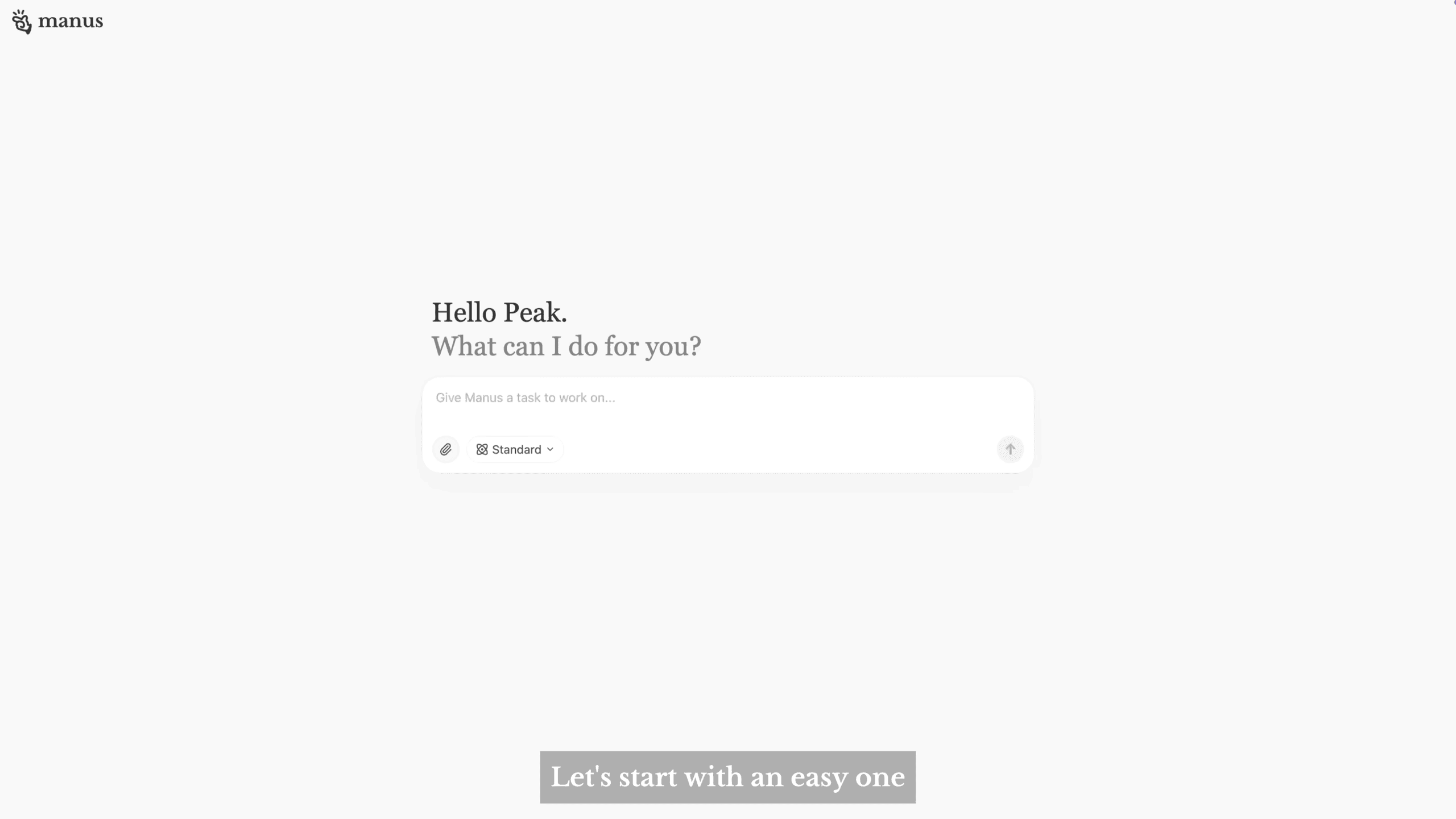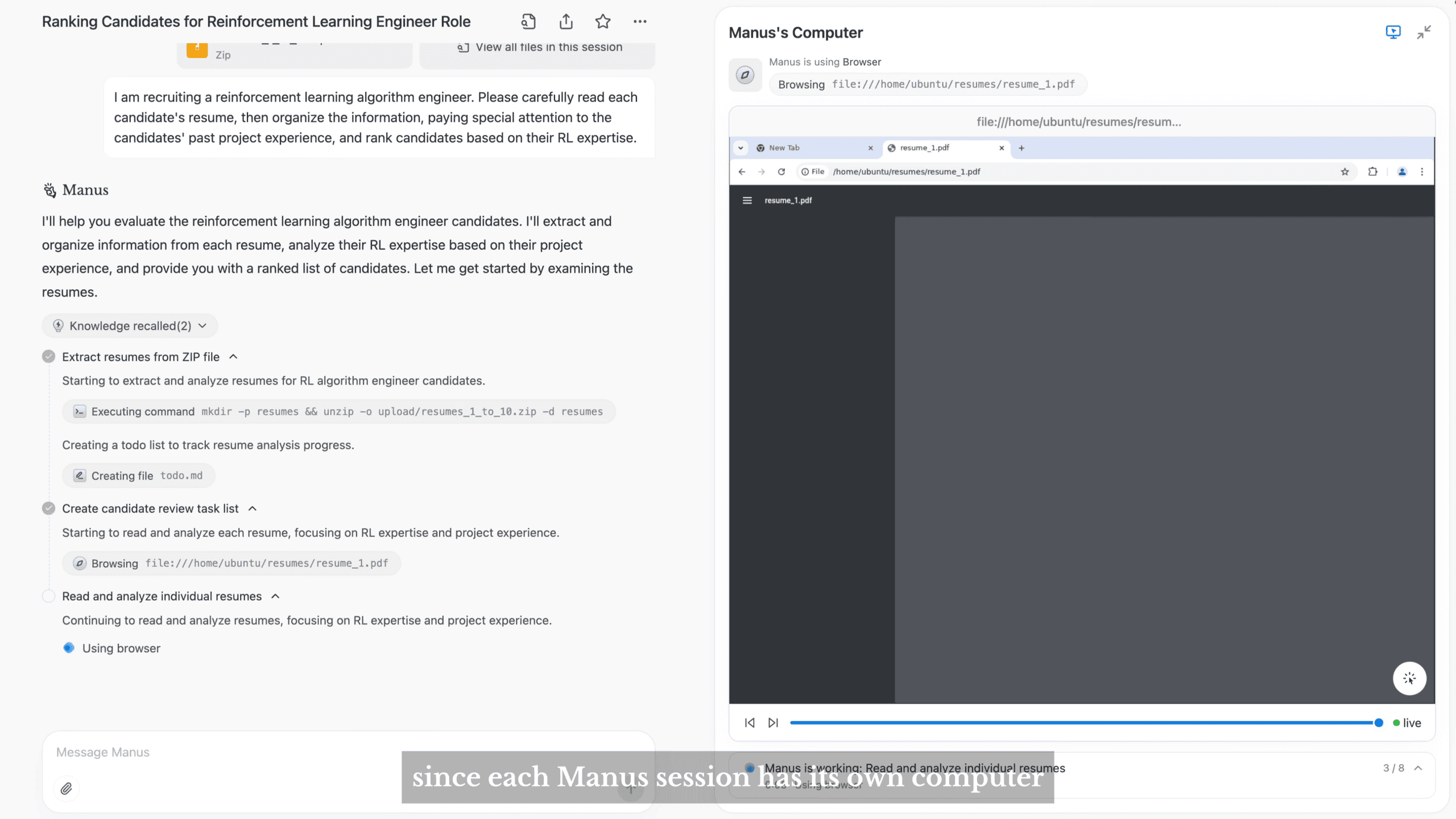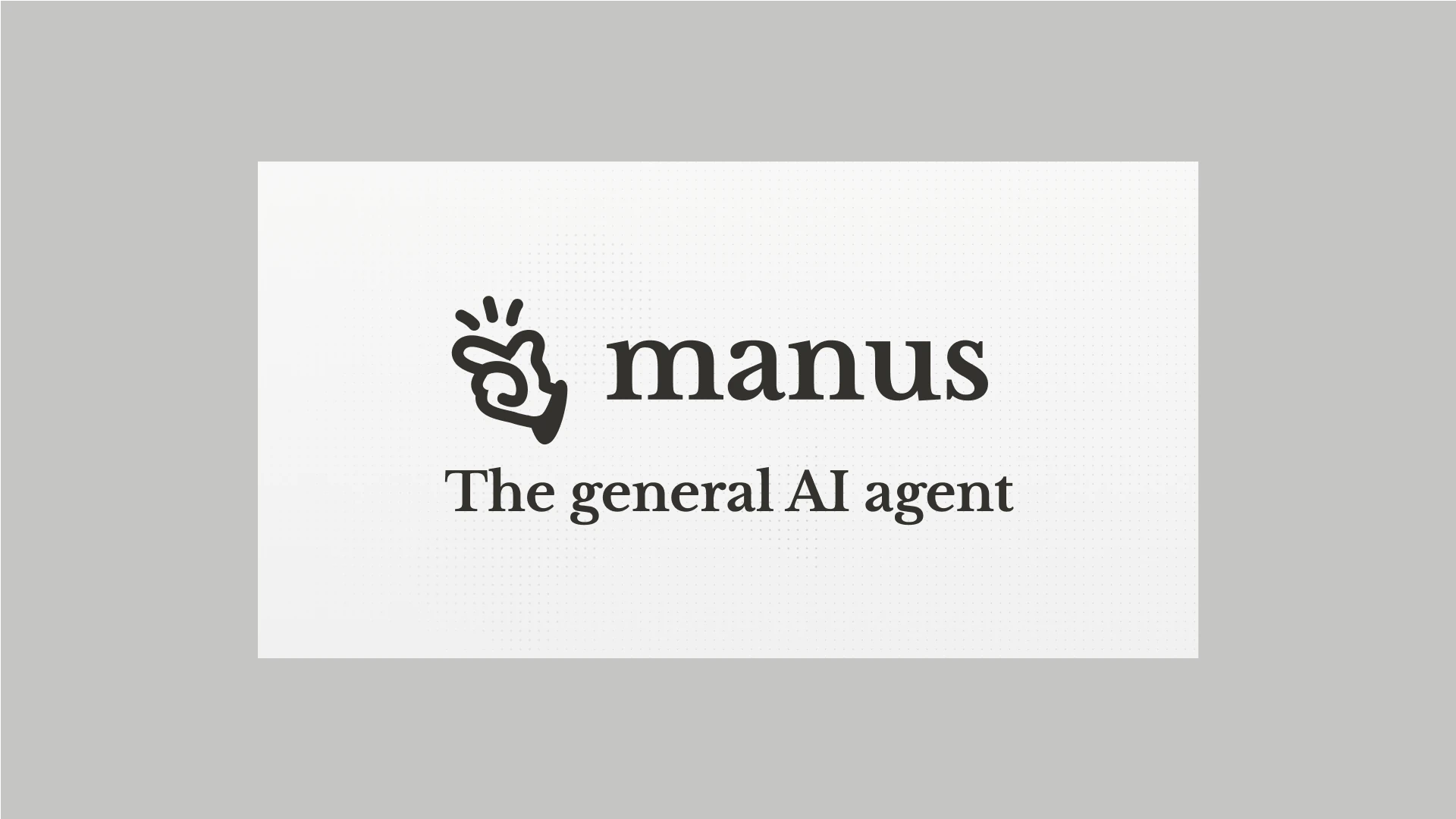Manus AI has been introduced, and this autonomous agent appears poised to redefine the future of artificial intelligence. Being called “the next deepseek” and even a “deepseek killer” by some, the platform marks a significant advancement into the realm of autonomous AI, surpassing the text-generating chatbots and virtual assistants we are familiar with.
Developed by the Chinese startup Monica, Manus is an autonomous AI agent capable of independently performing complex, real-world tasks with minimal human input. Its emergence signifies a paradigm shift, where machines not only assist but also proactively act on our behalf, dramatically transforming productivity and the way humans collaborate with machines.

At its core, Manus AI operates more like a self-governing digital employee than a simple chatbot. Unlike traditional AI systems—like OpenAI’s ChatGPT or Google’s Gemini—that rely on continuous user prompts and oversight, Manus understands broad instructions and takes it from there.
It can initiate multi-step processes, analyze evolving conditions, make informed decisions in real-time, and deliver completed outcomes—all while users focus elsewhere. Whether it’s analyzing stock correlations, sorting resumes, or evaluating real estate opportunities, Manus completes tasks that once required hours of human labor—often in a fraction of the time.
What Makes Manus AI Different?
Manus AI represents the cutting edge of multi-agent system design, where several specialized AI models collaborate seamlessly. This design mirrors an organization of virtual workers: each agent has a role (data analysis, decision-making, task execution), and together, they accomplish high-level objectives without micromanagement. Imagine telling Manus, “Find me a rental apartment in Beijing under $2,000 with a short commute to work,” and it independently scours listings, calculates commute times, analyzes market trends, and presents a shortlist—without requiring further direction.
This autonomy pushes Manus closer to what some experts view as the early stages of Artificial General Intelligence (AGI). AGI is the concept of AI that can perform any intellectual task a human can, and while Manus isn’t there yet, its ability to self-direct tasks and make judgment calls marks meaningful progress toward that vision.
How Manus AI Is Already Impacting Industries

In its private beta, Manus is being tested in industries where automation and efficiency are critical. Financial institutions are leveraging it to uncover hidden stock correlations and optimize trading strategies. HR departments are experimenting with it to streamline hiring processes by filtering and evaluating candidates beyond keyword matching. Even real estate firms are tapping Manus to conduct property analyses, calculating long-term investment potential at lightning speed.
Some believe Manus could disrupt white-collar work the same way industrial automation reshaped manufacturing. Tasks once thought uniquely human—like decision-making, negotiation, and complex analysis—are now increasingly within AI’s domain.
Why the Global Buzz (And Controversy)?
The launch of Manus AI has drawn comparisons to DeepSeek, another major Chinese AI achievement, and is fueling global conversations about China’s rapid progress toward AI dominance. Western firms like OpenAI and Google are watching closely, as Manus could set new benchmarks for what AI agents can accomplish.
However, there are concerns. Critics argue that autonomous agents like Manus raise data privacy and ethical questions. Who’s responsible when an AI makes a bad decision? How are users’ personal data protected when an AI is proactively making decisions on their behalf? These questions remain unresolved, but they’re becoming more urgent as Manus-type agents gain traction.
Adding to the intrigue, Manus is currently invite-only. Access codes are reportedly fetching high prices on the gray market, with some selling for thousands of dollars—a testament to the intense demand and curiosity surrounding the platform.
The Future According to Manus
As Manus AI moves toward a broader release, it’s clear this isn’t just another AI tool. It’s an ambitious reimagining of what AI can do when given autonomy. While skeptics warn of potential overreach, proponents argue Manus is ushering in a future where humans focus on creativity, strategy, and innovation, while autonomous agents handle the routine.

In the race toward smarter AI and AGI, Manus may well be one of the most significant milestones yet.
Key Takeaways
- Manus AI is an autonomous agent that independently completes real-world tasks based on human thoughts and instructions.
- Unlike traditional chatbots, Manus can execute complex multi-step processes without constant human guidance.
- This technology represents a significant advancement in artificial intelligence that could transform productivity and automation across various applications.
Understanding Manus AI
Manus AI represents a significant advancement in autonomous artificial intelligence. This system is designed to complete complex tasks with minimal human input, essentially turning thoughts into actions through its multi-agent architecture.
The Vision of Manus AI
Manus AI aims to bridge the gap between thinking and doing in the artificial intelligence space. Its developers describe it as “a general AI agent that bridges minds and actions: it doesn’t just think, it delivers results.” This vision pushes beyond conventional AI systems that merely respond to prompts.
The core concept behind Manus is creating an AI that works independently on behalf of users. Rather than requiring constant guidance, Manus can interpret instructions, plan necessary steps, and execute them without continuous human oversight.
This approach represents a shift toward more practical AI applications in everyday life and work environments. Users can assign tasks and focus on other priorities while Manus handles the execution.
Development and Capabilities
Manus AI operates as a multi-agent system, combining several specialized AI models to tackle complex tasks. This architecture allows it to break down assignments into manageable steps and solve problems in sequence.
The system can perform various work and life tasks independently. Its capabilities extend beyond simple responses to actually completing multi-step processes that previously required human intervention.
Key capabilities include:
- Task decomposition: Breaking complex jobs into smaller steps
- Independent decision-making: Choosing appropriate actions without guidance
- Cross-platform functionality: Working across different digital environments
Developed in China, Manus represents what some consider a significant breakthrough in autonomous AI technology. Its ability to function as a general-purpose AI agent distinguishes it from more narrowly focused systems.
Comparisons with Other AI Agents
Manus AI differs from traditional large language models (LLMs) and chatbots in its level of autonomy and action-oriented design. While most AI systems provide information or suggestions, Manus aims to complete actual tasks.
Unlike conventional digital assistants that require specific commands for each action, Manus can interpret broader instructions and determine the necessary steps independently. This positions it closer to the concept of Artificial General Intelligence than many existing systems.
When compared to other autonomous agents, Manus stands out for its comprehensive approach. Rather than specializing in one domain, it aims to handle diverse tasks across different contexts.
The system faces competition from other advanced AI projects but distinguishes itself through its focus on bridging the gap between planning and execution in real-world applications.
Applications of Manus AI
Manus AI showcases impressive capabilities across various sectors, combining autonomous operation with sophisticated task execution. Its practical uses range from everyday personal assistance to complex data analysis functions.
Personal Assistance and Task Automation
Manus AI can handle numerous everyday tasks without human guidance. It can autonomously browse websites, organize schedules, and manage emails, saving users significant time.
For travel planning, Manus can research destinations, compare flight prices, and create detailed itineraries based on user preferences. It doesn’t just provide recommendations—it can execute the entire planning process.
The system can also automate workflow processes by:
- Setting up recurring tasks
- Managing digital documents
- Organizing information across platforms
- Sending notifications and reminders
Unlike basic chatbots, Manus works independently to complete these tasks, requiring minimal user input once instructions are provided.
Data Analysis and Decision Making
Manus excels at handling large datasets and extracting meaningful insights. It can analyze stock market trends, evaluate financial reports, and generate comprehensive data visualizations.
The AI can create detailed spreadsheets and reports without human intervention. For businesses, this means faster access to actionable information for strategic decisions.
Some key analytical capabilities include:
- Market trend analysis
- Financial document evaluation
- Creation of data-driven reports
- Pattern recognition in complex datasets
These features make Manus particularly valuable for research, finance, and business intelligence applications where processing large amounts of information quickly is essential.
AI in High-Stakes Tasks
Manus is being developed to handle more critical responsibilities that traditionally required human oversight. It can evaluate insurance policies, analyze legal documents, and identify important clauses or conditions.
In healthcare settings, Manus could potentially assist with analyzing patient data and medical research, though human verification remains important for critical decisions.
For security applications, the system can monitor patterns and identify potential issues without constant supervision. However, ethical considerations and human oversight remain crucial for high-stakes applications.
The autonomous nature of Manus raises important questions about responsibility and accountability when AI systems make consequential decisions or recommendations in sensitive domains.
Innovations in AI: Manus AI’s Approach
Manus AI represents a significant leap in autonomous artificial intelligence systems. It combines cutting-edge AI models with adaptive learning capabilities while maintaining human collaboration at its core.
Advanced AI Models Integration
Manus AI distinguishes itself through its integration of sophisticated AI models that work together seamlessly. Unlike traditional AI systems that rely on single-purpose algorithms, Manus incorporates multiple specialized models that handle different aspects of problem-solving.
The system can process complex instructions, analyze diverse data formats, and generate solutions without constant human guidance. This multi-model approach allows Manus to tackle changing tasks with remarkable flexibility.
One key innovation is Manus’s ability to bridge thought and action. It doesn’t just analyze information but can execute tasks independently in digital environments. This capability stems from its architecture that connects reasoning components with execution modules.
Manus can conduct research, analyze data, and even build applications proactively rather than waiting for specific human prompts at each step.
Human-Machine Collaboration
Despite its autonomous capabilities, Manus AI was designed with human collaboration in mind. The system maintains feedback channels that allow for human oversight and intervention when needed.
This collaboration model represents a balance between independence and control. Humans can set boundaries, provide feedback, and guide the AI’s decision-making process without micromanaging every action.
The interface is designed to simplify complex interactions, making advanced AI accessible to users without technical expertise. This human-centered design philosophy helps bridge the gap between powerful AI capabilities and practical everyday use.
Users can communicate with Manus using natural language, reducing the learning curve typically associated with advanced technologies. This approach creates a more intuitive partnership between human and machine.
Adaptive Learning and Human Guidance
Manus AI continuously improves through adaptive learning mechanisms. The system analyzes the outcomes of its actions and refines its approaches based on success rates and human feedback.
This learning isn’t limited to predetermined datasets but extends to real-time interactions. When Manus encounters new challenges, it can adjust its strategies and develop novel solutions based on previous experiences.
Human guidance plays a crucial role in this learning process. Rather than relying solely on algorithmic optimization, Manus incorporates human preferences and priorities into its decision-making framework.
This guidance helps align the AI’s behavior with human values and expectations. The system can learn not just what works technically, but what solutions are most appropriate in different contexts.
Through this combination of autonomous learning and human direction, Manus aims to create AI that becomes increasingly helpful while remaining aligned with human needs.
Challenges and Considerations in AI Deployment
Deploying AI systems like Manus AI involves navigating several complex challenges that organizations must address proactively. These range from data privacy concerns to ethical implications and ensuring the overall quality of AI outputs.
Handling Sensitive Data
Organizations implementing AI systems must establish robust protocols for handling sensitive data. Personal data used to train algorithms requires special protection to prevent unauthorized access or breaches.
Privacy settings should be clearly defined and communicated to users whose information is being processed. Many users remain unaware of how their data is being used, creating potential risks of misuse.
AI systems often collect IP addresses and other identifying information, necessitating proper consent mechanisms. Explicit consent should be obtained before processing any personal information, with options for users to opt out.
Best practices for data handling:
- Implement data minimization principles
- Use encryption for stored and transmitted data
- Regularly audit data access permissions
- Create clear data retention policies
Ethical and Security Considerations
AI algorithms can perpetuate human biases present in training data. These biases may lead to unfair outcomes, particularly affecting marginalized groups.
The “black-box” nature of many AI systems creates transparency issues. When algorithms make decisions without clear explanations, accountability becomes difficult to establish.
Security measures must protect against both external threats and internal misuse. This includes preventing adversarial attacks designed to manipulate AI outputs.
Organizations should develop ethical frameworks specifically addressing:
- Fairness in algorithmic decision-making
- Transparency in how results are generated
- Responsibility for AI-related outcomes
- Prevention of harmful applications
Ensuring Quality and Reliability
AI systems require continuous monitoring to maintain accuracy and reliability. Regular testing helps identify performance degradation or unexpected behaviors.
Data integrity significantly impacts AI output quality. Poor or biased training data leads to unreliable results, undermining trust in the system.
Reproducibility presents a major challenge in AI deployment. Organizations must document methodologies and maintain version control to ensure consistent outcomes.
Quality assurance should include:
- Benchmark testing against established standards
- Regular validation using diverse datasets
- Human oversight of critical decisions
- Clear processes for addressing system failures
Human experts should review AI outputs in high-stakes situations. This human-in-the-loop approach helps catch errors that automated systems might miss.
Manus AI in the Broader AI Ecosystem
Manus AI has quickly established itself as a significant player in the autonomous AI agent landscape. Its ability to function independently across various tasks positions it uniquely among existing AI solutions.
Collaboration with Third-Party Tools and Services
Manus AI demonstrates remarkable flexibility in integrating with external systems and tools. Unlike traditional AI assistants that operate within limited parameters, Manus can connect to various applications to complete complex workflows autonomously.
This integration capability allows Manus to pull data from multiple sources, analyze information across platforms, and deliver comprehensive results. For businesses, this means fewer human interventions when performing tasks like resume screening, data analysis, and customer service operations.
Many organizations are exploring partnerships with Manus to enhance their existing tech stacks. The AI can function as a central coordinator between different services, creating smoother operational processes.
Manus AI’s Role in AI Education and Research
Manus represents a significant advancement in autonomous AI research. As described by developers, it “bridges minds and actions,” moving beyond theoretical capabilities to practical implementations.
Educational institutions have begun incorporating Manus case studies into advanced AI curriculums. The system’s ability to perceive, reason, and act independently provides valuable insights for researchers studying autonomous decision-making.
Manus outperforms several established AI systems on benchmark tests, particularly in the General AI Agent category. This has sparked collaborative research initiatives examining its reasoning methodologies.
For AI startups, Manus provides a reference architecture for developing truly autonomous systems. Its success demonstrates the market potential for AI that can operate with minimal human supervision while delivering reliable results.
Frequently Asked Questions
Many users have questions about Manus AI, its capabilities, and availability. These questions cover everything from basic features to technical details about this autonomous AI agent system.
What capabilities does the Manus AI offer to users?
Manus AI functions as a general AI agent that converts thoughts into actions. It can handle various tasks in both work and personal contexts.
The system excels at task automation, data analysis, content creation, and decision-making processes. This comprehensive capability set helps users increase their productivity.
Manus operates as a multi-agent system, combining several AI models to work independently on tasks without constant human supervision.
How can one access Manus AI services and is there an invitation code requirement?
Manus AI appears to have limited availability currently. Specific details about access methods aren’t widely published.
Some AI platforms operate on invitation-only systems during early deployment phases, but official information about Manus AI’s access requirements remains limited.
Users interested in Manus should check the official website for the most current access information.
Who is behind the development of Manus AI and what is their background?
The development team behind Manus AI has not been extensively profiled in the available information.
The system has been described in some sources as a Chinese AI breakthrough, suggesting development may have occurred in China.
More detailed information about the specific individuals or organization responsible for creating Manus AI is not provided in the search results.
What are the distinctions between Monica AI and Manus AI?
The search results don’t provide specific comparisons between Monica AI and Manus AI.
Both appear to be AI agent systems, but their exact differences in capabilities, design philosophy, and use cases aren’t detailed in the available information.
A proper comparison would require additional information about both systems’ specific features and limitations.
What are the costs associated with using Manus AI, and is there a free tier available?
The search results do not contain specific pricing information for Manus AI.
Many AI platforms offer tiered pricing models with free basic access, but whether Manus follows this approach isn’t confirmed in the available information.
Potential users would need to consult official Manus AI resources for accurate pricing details.
How does Manus AI integrate with other applications and services?
The search results don’t provide specific details about Manus AI’s integration capabilities with other software or services.
As a general AI agent system, it likely offers some form of integration with common applications, but the extent and methods aren’t specified.
More technical documentation would be needed to understand how Manus connects with existing software ecosystems and what APIs or interfaces it might offer.







